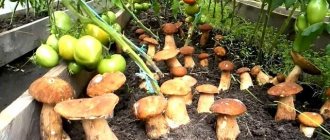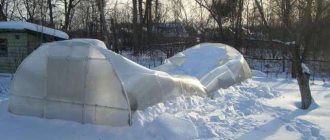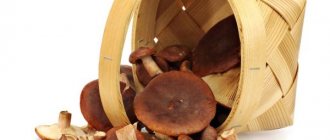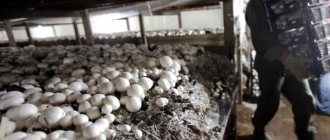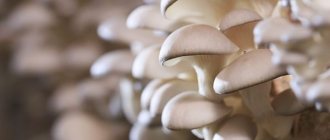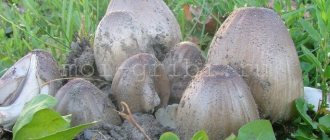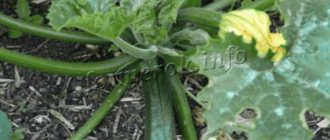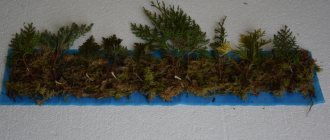Greenhouse requirements
You can grow mushrooms in a greenhouse made of any material - polycarbonate, film or glass. However, it must meet the following requirements:
- Have a heating system . It is better to give preference to a water system, since it does not dry out the air as much as other heating methods. As a rule, thanks to this installation, the air in the greenhouse is always fresh, which is important for the growth of mushrooms.
- Assume high-quality sealing and insulation . Without them, it will not be possible to maintain a stable microclimate in the room, as well as optimal levels of temperature and humidity.
- Have a ventilation system or supply and exhaust ventilation . It provides the mushrooms with the fresh air they need for rapid and proper development.
- Have an irrigation system . The mycelium needs regular watering, so it is important to ensure easy access to water. The method of spraying it is considered optimal. If the greenhouse is small, all manipulations can be done manually, but if it is large, then it is better to take care of a special spray system.
- Assume protection from direct sunlight . For these purposes, the roof of the structure can be covered with curtains made of a less transparent (matte) film or whitewashed with lime.
- Have the right equipment . A greenhouse for growing mushrooms also needs to be equipped with shelving or tables for placing containers. For the same purposes, you can use special racks on which blocks or containers are suspended.
Residential basements should not be equipped for growing mushrooms, since excessive dampness will lead to the destruction of the foundation and the collapse of the building.
Greenhouse organization
It is customary to grow mushrooms in cold weather - from October to April, so often for this purpose they use an ordinary greenhouse made of film, which has already been freed from vegetables. Meanwhile, in order to convert a conventional polycarbonate greenhouse for growing mushrooms, a number of changes will need to be made to the design. In the future, the converted greenhouse can also be used for growing seedlings and vegetables.
Sealing and insulation
If the greenhouse structure is installed efficiently, then it does not have gaps through which heat escapes. In this case, sealing will not be required. If the installation work was carried out incorrectly or, as a result of careless operation, damage, cracks and gaps formed in the shelter itself or between it and the frame, then the greenhouse will need to be sealed. To do this you need to do the following:
- Identify any damage to the film or polycarbonate and carefully seal it with tape.
- If there are gaps between the frame and the base, they need to be sealed using a high-quality sealant.
- Seal the door and windows with a rubber seal and additionally install locks.
- Cover the ground with foamed polyethylene with a metallized layer to provide thermal insulation from the cold soil.
To save money on heating, it is recommended to additionally insulate the interior of the greenhouse by making a second contour of the shelter:
- Place arcs made of PVC pipes or fiberglass reinforcement inside the greenhouse. Their height should be sufficient to place shelves with mushrooms in the greenhouse and allow the farmer to move freely.
- Pull a thick covering material over the installed materials.
It should be noted that the double shelter of a greenhouse has many advantages:
- improves thermal insulation;
- reduces exposure of mushrooms to direct sunlight and protects against additional burns;
- helps maintain a more even and stable microclimate, even in the event of sudden changes in temperature outside the greenhouse.
A greenhouse with double cover looks like this:
For additional insulation, you can also attach a polycarbonate frame to the inside of the greenhouse. The resulting air gap between the outer and inner sheets will provide excellent thermal insulation.
To protect mushrooms from sunburn, it is recommended to use colored or translucent polycarbonate.
Curtaining
If the greenhouse is insulated using colored polycarbonate or agrofibre, there is no need to curtain it, since these materials do an excellent job of dispersing sunlight and reducing illumination. Otherwise, curtaining is required, which can be done in two ways:
- install curtains made of thick fabric under the roof of the greenhouse;
- whitewash the structure with lime mortar.
Experienced farmers recommend choosing the second method, since whitewashing with lime not only helps protect mushrooms from solar radiation, but also perfectly disinfects the walls of the structure.
Ventilation
Mushrooms constantly need an influx of fresh air, especially during the period of active growth, so the greenhouse must be equipped with a ventilation system. It can be organized this way:
- Make a standard window above the doors or in the roof of the greenhouse. It is not advisable to make windows on the walls, since in this case a draft will pass through the mycelium itself.
- Install ventilation equipment, since it is not possible to keep the window open in any weather. In addition, access to it may be difficult if a double shelter is used. So, in the greenhouse you need to install pipes for supply and exhaust ventilation, passing them through the roof or end wall.
In order for the supply and exhaust ventilation to work in natural mode, that is, according to the laws of air exchange and without ventilation, the bottom of the supply pipe should be located at a height of 15-30 cm from the floor. This way the exhaust pipe will draw warm air from the ceiling.
- Equip a fan, since difficult air outflow and inflow cannot be ruled out. It should also be taken into account that some types of mushrooms (for example, oyster mushrooms) during certain periods of growth require a very high volume of incoming air, which is almost impossible to provide without a forced ventilation system.
Natural ventilation of the greenhouse can be organized as follows:
Water supply
To water the substrate and maintain the required level of humidity, you need to organize a fine spray of water in the mushroom picker. For maximum cleaning, you should also install a filter. This is a mandatory condition if water is supplied from the sewer.
When choosing an irrigation system, you need to proceed from the size of the room:
- If the greenhouse is small, you can get by with hand sprayers. To do this, it is enough to water the crop using a hand sprayer. In addition, when watering by hand, experts recommend placing tanks of water directly under the mycelium in order to maintain its reserves and a suitable temperature, as well as increase the level of humidity in the mycelium.
- If the greenhouse is large or there is no desire to waste time on watering, you should install a full-fledged air humidification system, which will also water automatically. To water the mycelium with soft and melt water, it is necessary to install a system of tubes connected to a pump into the soil. For large farms, you can install a tube that automatically moves along the guides and creates the pressure necessary to evenly spray water onto the racks with mushrooms. Thus, the humidity of the air and the substrate is simultaneously maintained.
The best indicators of acidity (pH) and hardness (dGH) have melt, rain or river water, which should be used for spraying the substrate and mycelium.
Heating system
To maintain the optimal temperature for mushrooms in the greenhouse in winter, it is necessary to install a heating system. It is easier to do this by connecting the greenhouse to the water heating of the house through a balancing valve, with the help of which it is easy to regulate the temperature in the desired range.
If it is not possible to connect to water heating at home, you will have to install an independent heating device. In this case, the best option is an electric boiler, which is equipped with an automation and safety system. If the size of the greenhouse is small, you can choose a device of low power and affordable cost. It has the following advantages:
- allows you to easily adjust the temperature as the mushrooms develop;
- maintains the set air temperature automatically;
- requires little space;
- easy to install and connect in accordance with the attached diagram;
- does not require installation of a chimney.
The heating circuit with an electric boiler looks like this:
It should be noted that modern boiler models are equipped with a built-in expansion tank and circulation pump, which ensures safe operation and uniform heating of the entire greenhouse.
As for the disadvantages of electric boilers, we can only highlight the high costs of electricity. To minimize them, you will need to properly insulate and seal the room, leaving no cracks or gaps. In this case, the costs will be moderate, especially considering that the mushrooms do not require too high an air temperature.
Radiators or registers made of large-diameter pipes, which are placed around the perimeter of the room at a low height, are also suitable as heating devices.
To reduce heating costs, radiators and temperature sensors should be located inside the additional shelter.
Lighting
This factor mainly depends on the variety of mushrooms. For example, oyster mushrooms do not require any lighting, so you can get by with placing lamps in the greenhouse for your own convenience. If you plan to grow champignons and some other types of mushrooms, this issue will need to be given due attention.
In the second case, it is better to place fluorescent lamps with a power of 100-180 lux/h in the greenhouse. At the same time, lamps that are marked DRL and DRLF are of higher quality, since they emit a red-blue spectrum that is ideal for mushrooms. Such rays are invisible to the human eye, but plants are especially sensitive to them.
The selected lamps must be evenly distributed throughout the greenhouse, and it is advisable to hang them on the ceiling. If this is not possible, lighting fixtures can be placed on the walls.
It is necessary to use additional lighting on cloudy days and during the ripening period of mushroom caps.
Features of cultivation
Oyster mushrooms
How to grow oyster mushrooms in a greenhouse? Oyster mushrooms can be grown in two main ways: on wood blocks or in bags. In the second case, it is necessary to prepare thick bags and fill them with substrate. Fine straw, sawdust or buckwheat husks can be used in this capacity; they can be taken either individually or in mixed form.
You need to add a little mycelium to the substrate , place it in bags and tie them up. Oyster mushroom mycelium grows very quickly, in some cases it even has to be divided.
It is necessary to make 7-10 holes in the bag, from which mushrooms will grow in the future. At the last stage, the bags should be placed suspended on hooks or ropes.
Growing oyster mushrooms in a greenhouse in the second way involves planting mycelium on pieces of wood; for this you will need wooden blocks. Pre-moistened pieces of wood are covered with mycelium, the smallest parts of which penetrate the tree and become fixed in it within a couple of days.
At the next stage, it is necessary to lay roofing felt or plastic film on the area intended for germination , sprinkle it with a mixture of sand, earth and sawdust, lay bars on top every 30 cm. Cover them on top with earth and small sawdust, sprinkle with manure, lay agrofibre on top .
Useful video about growing oyster mushrooms:
Champignon
How to grow champignons in a greenhouse? The most important thing when growing champignons is the creation of favorable conditions. The optimal level of air humidity is 75-90%, temperature can fluctuate between 0-25 degrees.
For planting, it is recommended to choose the most hidden areas; the substrate should consist of horse manure and straw.
The technology for growing champignons in a greenhouse is as follows: at the first stage, straw and manure must be placed in piles, sprinkled with ammonium nitrate on top , in a proportion of 4 kg per 1 cubic meter, watered, and left for four days. During this time, the compost warms up, after which it must be dug up and chalk added to the mixture at the rate of 1 kg per 1 cubic meter, after which the substrate is moistened.
Repeated digging is carried out after another four days, for 1 cubic meter. 4 kg of superphosphate and 10 kg of alabaster are added to the mixture. The third digging is carried out after the same period of time, the same substances are added. After this, with a break of four days, four more diggings are carried out without additives; approximately on the 24-25th day, the substrate must be laid out on the beds; the pH of the soil should not deviate much from 7.5 .
The resulting mixture must be laid out on beds, in bags or boxes, the depth of the compost is 20 cm, when grown in plastic bags -4 0 cm. An important role when planting mycelium is played by the soil temperature, it should fluctuate in the range of 25-30 degrees (at a depth of 5 cm).
If this condition is not met, the mycelium may not germinate. In the beds, it is necessary to make holes every 25 cm and 8 cm deep; three-centimeter pieces of mycelium should be placed in them; compost and wet newspapers should be placed on top.
In case of high humidity, the mycelium can be scattered over the garden bed; lighting can be minimal . To maintain a humidity level of 85-90%, the floor must be watered periodically.
The first mushrooms appear within two weeks; something like a silvery web forms on the surface. After the appearance of a mushroom smell, the newspapers should be replaced with a special mixture consisting of peat and lime (crumbs) in proportions of 3:1. The layer thickness should be 3-4 cm; light alkaline soil mixtures can also become a peat substitute.
The mycelium is covered with moistened soil, the temperature should be maintained at 14-17 degrees. After another 2-3 weeks you should wait for the first harvest; after a break of 8-10 days, the mycelium begins to bear fruit again.
The crop should be harvested at the stage when the film cover is closed. It is not recommended to grow mushrooms again in the same place ; the substrate is used as fertilizer.
Useful video about growing champignons:
What kind of shelving should I put in the greenhouse?
In the greenhouse you need to install shelving or racks, depending on the technology for growing mycelium and the type of mushrooms. Furniture can be made of wood or metal, but the second option is preferable. The fact is that metal structures are easy to process and disinfect, and also do not rot in high humidity conditions. In addition, racks can be easily made from leftover metal, for example, using scraps of reinforcing bar.
Some types of fungi can settle on wood, causing its rapid destruction, so it is likely that wooden shelving will have a short service life.
The design of the rack should be chosen depending on the method of growing mushrooms. So, if you plan to grow them on pallets, you should place racks with several wide shelves in the greenhouse. For more convenient operation, they can be installed at a slight slope.
If you plan to grow mushrooms in briquettes with a substrate, it is better to place narrower shelves or racks in the greenhouse from which the briquettes can be hung. It should be noted that some people prefer to place them directly on the greenhouse floor.
Racks for hanging bags with substrate
Compost recipe for champignons
- 100 kg of manure (90 kg of chicken droppings);
- 100 kg of straw (an environmentally friendly product without mold, before adding the straw is soaked and kept in water for up to two days);
- 500 l of water;
- 6 kg of gypsum (to bind ammonia and preserve nitrogen in the compost).
All of the listed components are poured into piles in layers, starting with straw, followed by a layer of manure, and then the layers are repeated. The compost pile should be of such a size that air can circulate freely in the substrate.
The compost pile is turned over from time to time. Add water, add plaster and mix thoroughly. As a result of all manipulations, you should get a homogeneous compost that does not smell of ammonia and does not stick to your hands, otherwise the pile will have to be broken up again.
How to make a greenhouse for growing mushrooms all year round?
To harvest mushrooms all year round, it is advisable to install a special greenhouse in which there is practically no natural light, and a high level of thermal insulation is ensured by digging into the ground and filling the roof with a biodegradable layer, for example, manure.
Meanwhile, the types of structures may differ depending on what materials are used to build the greenhouse - wood, film or polycarbonate. Let's look at all three options in more detail.
Wooden structures
Greenhouses made of wood are suitable for growing different types of mushrooms. They can be assembled from elements such as:
- wooden walls (board or frame);
- compacted clay floor;
- garden bed;
- racks;
- roof;
- thermal insulation layer made of manure;
- choke with valve.
It should be noted that the wooden structure itself can be assembled according to various schemes. The following greenhouses are popular:
- Two-tier 4-flange . It is buried 500-600 mm into the ground, insulated with a mixture of manure and clay. The length of such a structure can be from 25 to 30 m. On average, it occupies an area of 200-230 square meters. m. Heating in such a greenhouse can be provided by electric, gas or stove. Inside the greenhouse, there is little or no natural light. What this design looks like can be seen in the diagram (Fig. A).
- Grachevskaya 7-flange model 1861 . The design according to Grachev is recognized as the most convenient for cultivating mycelium. Its length can be 4, 8, 15 or 25.2 m, and its area can be 100, 200 or 300 sq. m. m. This greenhouse is similar to a two-tier 4-flange design, but is slightly modernized to accelerate the growth of mushrooms. You can see how it looks in the diagram (Fig. B).
- Combined two-tier 4-flange . Its length is 20 m, and its working area is 123 sq. m. m. Such a greenhouse differs from the usual 4-flange design only in size and internal configuration, as can be seen in the following diagram (Fig. B).
1 – wooden wall; 2 – flank or bed; 3 – compacted clay floor; 4 – wooden stand with crossbars; 5 – gable wooden roof; 6 – thermal protection in the form of a layer of horse manure, which is covered with snow in winter; 7 – vent or choke in the form of a wooden box with a felt-lined valve.
Interestingly, Moscow gardeners often use combined 4-flank greenhouses with heating to grow mushrooms from September to February. When their rotation is complete, they use the greenhouse to grow early vegetables, having first replaced the wooden roof with greenhouse frames.
Film greenhouse
The basis of this design is a metal or wooden frame, which is hermetically sealed with a thick film. This option is perfect for year-round cultivation of wild mushrooms.
To provide the greenhouse with the proper level of thermal insulation and prevent excessive sunlight from reaching its walls, it is recommended to make the structure double - with an air pocket and an empty sealed space.
Polycarbonate greenhouse
Like the previous design, this greenhouse consists of a metal or wooden frame, but it is covered not with film, but with sheets of translucent polycarbonate. The frame can be rectangular or made in the form of half a cylinder. To grow mushrooms in such a greenhouse for 12 months in a row, it should also be built with a double wall and an air gap.
Useful tips
To build a greenhouse and safely grow mushrooms in it, you should take into account a number of recommendations from experts:
- For the structural frame, the best material is aluminum, as it is lightweight and wear-resistant. In addition, such material is not afraid of corrosion, and mold will not form on it even in conditions of high humidity. For the same reasons, it is worth installing shelving and racks made of aluminum in the mycelium.
- In order to improve thermal insulation, the floor should be covered with foamed polyethylene or other material that has similar properties. In addition, it is necessary to pay due attention to sealing the greenhouse, since any cracks and holes in the shelter lead to a decrease in the heat level, and therefore to an increase in heating costs.
- The greenhouse in which it is planned to grow mushrooms cannot have a translucent or transparent roof. It needs to be built or converted in such a way that the incoming light is dim. To do this, you can use several tricks: paint the translucent ceiling with chalk;
- tint the roof and walls with special adhesive tape or mesh;
- curtain with synthetic translucent fabric.
If you need to organize additional lighting inside the greenhouse, you can install fluorescent lamps.
What mushrooms to grow in a greenhouse?
In a well-equipped greenhouse you can grow almost any variety of mushrooms, but the most popular are:
- oyster mushrooms;
- Champignon;
- shiitake;
- White mushrooms.
To breed them in large quantities, you should divide the greenhouse into several isolated rooms, and also install special equipment - a steam generator.
In a well-designed greenhouse, you can grow mushrooms in large quantities, even in the most severe frosts. To do this, it is important to ensure the proper level of humidity and lighting in the greenhouse, as well as take care of its sealing and insulation.
1
0
Copy link
What do champignons suffer from?
How to grow healthy champignons? To do this, you need to very carefully monitor both the external conditions in the greenhouse and the condition of the mushrooms themselves, which are prone to diseases and pest damage.
Rot
Rot on the surface of a mushroom can be determined with the naked eye: brown and gray spots, deformations and an unpleasant odor are the first signs of rot. Having broken the mushroom, observe the discolored pulp. All spoiled mushrooms and mycelium are carefully removed, and the recesses are sprinkled with earth.
Mold
Signs: appearance of rusty or gray spots.
Fruits affected by mold are also removed along with the mycelium, capturing a certain amount of neighboring champignons to prevent the disease from spreading over a large area. To disinfect, sprinkle the infected area with table salt. Diseased fruits are burned, and clothes and hands are thoroughly disinfected.
